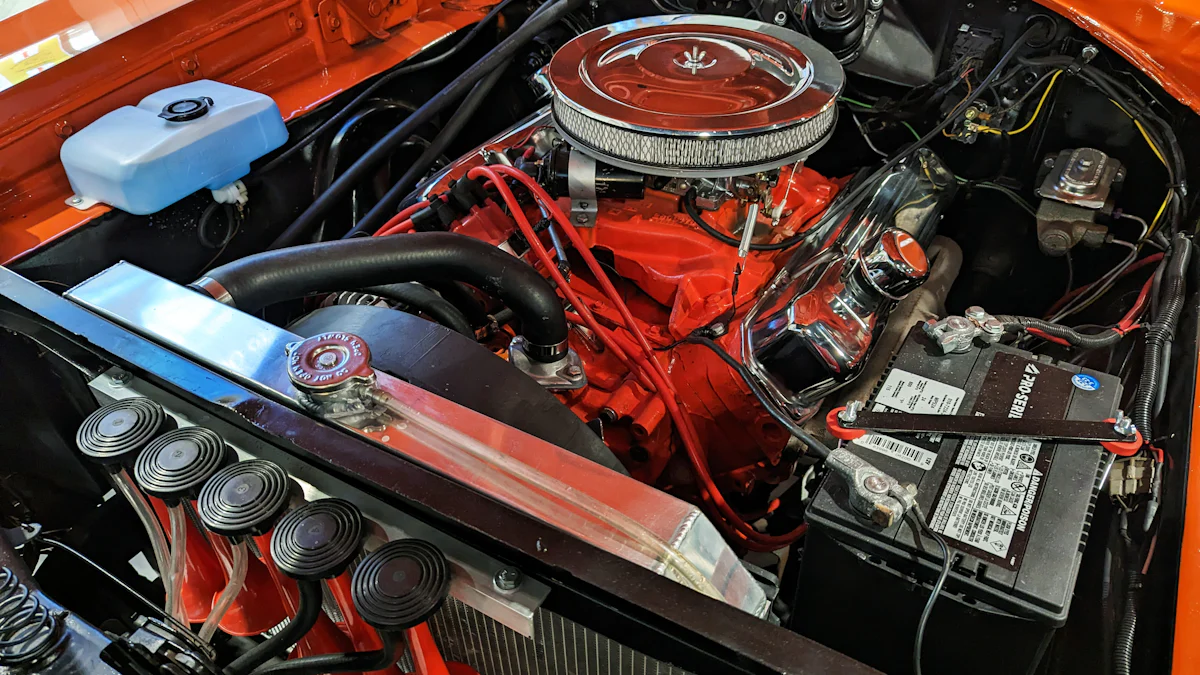The Strategic Importance of ODM in Product Development

Original design manufacturers play a pivotal role in modern product development. Their expertise streamlines the entire process, enabling brands to bring products to market faster. By leveraging pre-designed and tested models, companies can reduce development costs and minimize risks. ODMs also optimize production processes, cutting overhead expenses and ensuring cost efficiency. This approach allows businesses to focus on branding and marketing while maintaining competitive pricing. In fast-paced industries, partnering with an ODM provides a strategic advantage, fostering innovation and enhancing brand competitiveness.
Key Takeaways
Partnering with an ODM accelerates your time-to-market, allowing you to respond quickly to consumer demands and stay competitive.
Utilizing ODMs can significantly reduce development costs by minimizing the need for in-house resources and overhead expenses.
ODMs provide access to specialized expertise and advanced technologies, ensuring high-quality products that meet industry standards.
Focusing on branding becomes easier when you collaborate with an ODM, as they handle the complexities of design and production.
Choosing the right ODM partner is crucial; consider their industry experience, production capacity, and technological capabilities.
Effective communication and clear objectives are key to a successful collaboration with an ODM, enhancing productivity and innovation.
Long-term partnerships with ODMs can drive sustained growth and allow for scalability as your business evolves.
Understanding the Role of Original Design Manufacturers in Product Development

Defining Original Design Manufacturers
An Original Design Manufacturer (ODM) is a company that designs and produces products, which are then branded and sold by another business. Unlike traditional manufacturers, ODMs take full responsibility for the product's design and development. This approach allows brands to bypass the complexities of creating new products from scratch. By leveraging the expertise of ODMs, companies can focus on their core competencies, such as marketing and distribution.
ODMs often operate in industries where innovation and speed are critical. For example, in the electronics sector, ODMs design cutting-edge devices that meet market demands. Their ability to deliver ready-to-market solutions makes them indispensable partners for businesses aiming to stay competitive.
Key Benefits of ODM in Product Development
Collaborating with an Original Design Manufacturer offers several strategic advantages:
Accelerated Time-to-Market: ODMs streamline the product development process. Their pre-designed models and manufacturing expertise enable brands to launch products faster, meeting consumer demands in dynamic markets.
Cost Efficiency: By handling design and production, ODMs reduce the need for in-house resources. This approach minimizes overhead costs and eliminates the expenses associated with maintaining a dedicated design team.
Access to Expertise: ODMs bring specialized knowledge and advanced technologies to the table. Their experience ensures high-quality products that align with industry standards.
Focus on Branding: Partnering with an ODM allows companies to concentrate on building their brand identity. With the manufacturing process managed externally, businesses can allocate more resources to marketing and customer engagement.
Scalability: ODMs provide the flexibility to scale production based on market demand. This adaptability is particularly valuable for businesses experiencing rapid growth or seasonal fluctuations.
Examples of ODM Success Across Industries
Original Design Manufacturers have demonstrated their value across various sectors:
Electronics: Companies like Apple collaborate with ODMs to produce accessories such as chargers and headphones. These products, designed and manufactured by ODMs, maintain the quality and innovation associated with the Apple brand.
Fashion: In the apparel industry, ODMs design and produce clothing lines for global brands. This partnership enables fashion companies to introduce new collections quickly while maintaining consistent quality.
Consumer Goods: A tech company might partner with an ODM to develop a new line of smartphones. The ODM manages the entire process, from initial design to final production, allowing the brand to focus on marketing and distribution.
"ODMs empower brands to innovate without the burden of in-house design and manufacturing," a sentiment echoed by many industry leaders.
In regions like Huizhou Zhongkai High-tech Zone, ODMs play a crucial role in fostering technological advancements. Their contributions drive innovation and support the growth of global brands.
Branding Implications of Original Design Manufacturers
How ODM Shapes Brand Identity
An Original Design Manufacturer (ODM) plays a critical role in shaping a brand's identity. By offering pre-designed products, ODMs enable companies to focus on creating a unique brand image rather than investing heavily in product design. This approach allows businesses to align their branding strategies with consumer expectations while maintaining consistency across their product lines.
ODMs also provide opportunities for customization, which helps brands differentiate themselves in competitive markets. Companies can collaborate with ODMs to modify existing designs, ensuring that the final product reflects their brand values and aesthetic. For instance, a tech company might work with an ODM to develop a smartphone with unique features that resonate with its target audience. This collaboration not only enhances the product's appeal but also strengthens the brand's identity in the market.
"A strong brand identity begins with a product that embodies the company's vision and values," a principle that underscores the strategic importance of ODM partnerships.
Customer Perception of ODM Products
Customer perception of ODM products often hinges on the quality and innovation associated with the brand. When a company partners with a reputable ODM, it gains access to advanced technologies and expertise, which translates into high-quality products. This quality assurance fosters trust among consumers, enhancing their perception of the brand.
However, transparency in branding remains essential. Customers value authenticity and may question the originality of products if they perceive them as generic or mass-produced. To address this, companies must emphasize their role in customizing and branding ODM products. Highlighting unique features or design elements can reassure customers of the brand's commitment to delivering tailored solutions.
In regions like Huizhou Zhongkai High-tech Zone, ODMs contribute significantly to technological advancements. Their innovative designs and manufacturing capabilities help brands meet evolving consumer demands, further enhancing customer trust and satisfaction.
Balancing Customization and Consistency in Branding
Balancing customization and consistency is crucial for maintaining a cohesive brand image. While ODMs offer flexibility in product design, excessive customization can dilute the brand's identity. Companies must strike a balance by ensuring that customized products align with their overall branding strategy.
Consistency in branding extends beyond product design. Packaging, marketing materials, and customer service must also reflect the brand's values and aesthetics. By collaborating closely with ODMs, companies can ensure that every aspect of the product aligns with their branding goals.
For example, a fashion brand working with an ODM to produce a new clothing line might focus on maintaining consistent color schemes and design elements across all products. This approach reinforces the brand's identity while allowing room for innovation and creativity.
"Customization should enhance, not compromise, a brand's identity," a guiding principle for businesses leveraging ODM partnerships.
Comparing Original Design Manufacturers with Other Manufacturing Models

ODM vs. OEM: Key Differences and Strategic Use Cases
Original Design Manufacturers (ODMs) and Original Equipment Manufacturers (OEMs) represent two distinct approaches to product development and manufacturing. Each model offers unique advantages, making the choice between them highly dependent on a company's goals, resources, and market strategy.
Key Differences:
Control Over Design: OEMs allow companies to retain full control over the product design process. Businesses provide detailed specifications, and the OEM focuses solely on manufacturing. In contrast, ODMs take responsibility for both design and production, offering ready-to-market solutions that simplify the development process.
Cost Efficiency: ODMs typically provide a more cost-effective option. Their pre-designed models reduce development expenses and lower minimum order quantities. OEMs, however, often require significant investment due to the custom design and development involved.
Speed to Market: ODMs excel in accelerating product launches. Their streamlined processes enable brands to respond quickly to market demands. OEMs, while flexible in accommodating brand requirements, may require more time due to the customization involved.
Innovation and Expertise: ODMs leverage their design expertise to create innovative products that align with industry trends. OEMs, on the other hand, focus on specialized manufacturing capabilities, allowing businesses to maintain strict quality control.
Strategic Use Cases:
ODM: Ideal for companies seeking rapid market entry, cost efficiency, and access to design expertise. For example, startups with limited resources can partner with an ODM to launch products without investing heavily in R&D.
OEM: Suitable for businesses prioritizing customization and control over product design. Established brands with specific design requirements often choose OEMs to ensure their products meet exact specifications.
"The choice between ODM and OEM depends on a company's priorities—whether it values speed and cost savings or customization and control."
ODM vs. In-House Manufacturing: Cost, Scalability, and Flexibility
When comparing ODMs to in-house manufacturing, businesses must evaluate factors such as cost, scalability, and operational flexibility. Each approach has its strengths, and the decision often hinges on a company's long-term objectives.
Cost Considerations:
ODMs significantly reduce costs by handling both design and production. Companies avoid the expenses associated with maintaining in-house design teams, purchasing equipment, and managing production facilities.
In-house manufacturing requires substantial upfront investment. Businesses must allocate resources for infrastructure, skilled labor, and ongoing maintenance.
Scalability:
ODMs offer unparalleled scalability. They adapt production volumes based on market demand, making them ideal for businesses experiencing rapid growth or seasonal fluctuations.
In-house manufacturing may struggle to scale efficiently. Expanding production capacity often involves additional investments in equipment and workforce.
Flexibility:
ODMs provide flexibility in product design and development. Companies can collaborate with ODMs to customize products while benefiting from their expertise and resources.
In-house manufacturing offers greater control but limits flexibility. Adjusting production processes or introducing new designs can be time-consuming and costly.
Strategic Insights:
ODM: Best suited for companies aiming to minimize costs and streamline operations. For instance, a tech brand in Huizhou Zhongkai High-tech Zone might partner with an ODM to leverage advanced manufacturing capabilities and focus on branding.
In-House Manufacturing: Ideal for businesses with the resources to invest in infrastructure and a need for complete control over production.
"Choosing between ODM and in-house manufacturing requires a careful assessment of cost, scalability, and operational goals."
Strategic Insights for Leveraging Original Design Manufacturers
Choosing the Right ODM Partner
Selecting the right Original Design Manufacturer (ODM) partner requires a strategic approach. Companies must evaluate potential partners based on their expertise, reliability, and alignment with the brand's goals. A thorough assessment of the ODM's track record ensures that the partnership will deliver consistent quality and innovation.
Key factors to consider include:
Industry Experience: An ODM with extensive experience in a specific industry can provide valuable insights and proven solutions. For instance, tech companies in regions like Huizhou Zhongkai High-tech Zone often collaborate with ODMs specializing in advanced electronics manufacturing.
Production Capacity: The ability to scale production according to market demand is crucial. Businesses should confirm that the ODM can handle both small and large-scale projects without compromising quality.
Technological Capabilities: Advanced manufacturing technologies and design expertise set top-tier ODMs apart. Companies should prioritize partners who invest in innovation and stay ahead of industry trends.
Communication and Transparency: Clear communication fosters trust and ensures that both parties remain aligned throughout the collaboration. Transparency in processes, timelines, and costs strengthens the partnership.
"Choosing the right ODM partner is not just about capabilities; it’s about finding a collaborator who shares your vision and commitment to excellence."
Best Practices for Successful ODM Collaboration
Effective collaboration with an ODM involves more than signing a contract. Companies must actively engage in the partnership to maximize its benefits. Adopting best practices ensures a smooth and productive relationship.
Define Clear Objectives: Establishing clear goals at the outset helps both parties understand expectations. This clarity minimizes misunderstandings and keeps the project on track.
Foster Open Communication: Regular updates and feedback sessions enhance collaboration. Companies should maintain open lines of communication to address challenges promptly.
Leverage the ODM's Expertise: Trusting the ODM's knowledge and experience allows businesses to benefit fully from the partnership. Companies should seek advice on design improvements and production efficiencies.
Monitor Quality Control: While ODMs handle production, brands must ensure that quality standards align with their requirements. Periodic audits and inspections help maintain consistency.
Adapt to Market Changes: Flexibility is key in dynamic industries. Companies should work closely with their ODM to adjust strategies and designs based on evolving consumer demands.
"Collaboration thrives on mutual respect and shared goals. By working together, brands and ODMs can achieve remarkable results."
Long-Term Strategies for ODM Integration
Integrating an ODM into a company's long-term strategy requires careful planning. Businesses must view the partnership as a collaborative effort that evolves over time. This approach ensures sustained growth and innovation.
Build Strong Relationships: Long-term success depends on trust and mutual understanding. Companies should invest in building strong relationships with their ODM partners.
Invest in Joint Innovation: Collaborative innovation drives competitive advantage. Brands can work with ODMs to develop unique products that set them apart in the market.
Align Branding Efforts: Consistency in branding strengthens market presence. Companies should ensure that ODM-produced products reflect their brand identity and values.
Plan for Scalability: As businesses grow, their needs change. Companies should choose ODMs capable of scaling operations to meet future demands.
Evaluate Performance Regularly: Periodic reviews of the partnership help identify areas for improvement. Companies should assess the ODM's performance against predefined metrics.
"A successful ODM partnership is a journey, not a transaction. Long-term collaboration unlocks new opportunities and drives sustained success."
Original design manufacturers offer businesses a strategic edge by streamlining product development and branding. Their expertise reduces time-to-market, lowers R&D costs, and enables rapid innovation. Selecting the right ODM partner ensures consistent quality and alignment with brand goals. By leveraging ODM partnerships, companies can focus on scaling operations, enhancing efficiency, and driving long-term growth. These collaborations empower brands to meet evolving consumer demands while maintaining competitiveness.
Discover how partnering with an Original Design Manufacturer can transform your product development strategy and elevate your brand in today’s competitive market.
See Also
Maximizing Growth Through High-tech Zones Strategies
Discovering Zhongkai: Unexpected Advantages for Mobile Manufacturing
Revolutionizing Commerce: The Influence of Zhongkai High-tech Zone
Huizhou's High-tech Zone: Driving Force Behind Industrial Expansion
Huizhou Zhongkai's Innovative Approach to Sustainable Growth
Zhongkai High tech Zone National foreign trade transformation and Upgradi Base(Electronic Information)Cloud Platform.
Address: Zhongkai High-tech Zone,Huizhou City ,Guangdong,China
E-mail: huizhoueii@163.com 13510001271@163.com
Tel: +86-0752-3279220 Mobile: +86-13510001271


